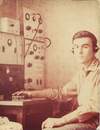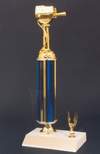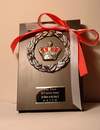|
My name is Zoltan Nemeth, I was born on May 28 of 1943. After finishing
the elementary school I finished the Oil mining and Deep Drilling Technical
highschool, then I studied radio-television mechanic profession and I
worked as mechanic. Later I finished technical class at Tivadar Puskas
Telecommunication school. In 1968 I got married, I have two sons, they
both work with computers. As my parents told me I was 3-4 years old when
I eagerly turned the radio receiver's tuner. Maybe it started at that
age? In 1958 I got my hands on a Radiotechnics magazine, it was a milestone
in my future, either I think of my hobby or work.
|

As it began...
|
Still in that year I passed the observer exam, and started to work with
the callsign HA1-0215 then later HA1-704. As observer I was listening
for radio amatuers working on shortwave. The technical side of HAMing
was interesting for me, so I started to extend my knowledge by building
a 0-V-2 radio receiver. I converted this later to a super system. In 1961
I passed the "A" exam and in 1962 I got the HA1ZH callsign.
The first QSO, 1962 May 26. OK3CCM 3,5MHz cw
rst 599
In 1962 I started to work with a home built 10W telegraph,
then later with a AM mode radio. The antenna I used was a VS1AA. One year
later I passed the "B" exam, and this allowed me to work on
every HAM bands. In 1963 the radio got smaller, although I extended the
power to 50W. The antenna was the popular G5RV.
|

In 1963 the rig got smaller,
|
In 1966 with †HA1ZF
Janos Andel radio amateur we formed the radio club in Nagykanizsa, I became
the administrator. The club owned the HA1KZH callsign, and I was responsible
for the trasmitter for some years. The first radio was a home built one.
The operator training started, and some of them later got their own authorization.
In 1968 I started to build
an SSB transmitter with a 9MHz filter which was the base for the 5 band
SSB transceiver I built later. Soon enough my antenna got extended on
the higher bands 14-21-28MHz with a 2 element QUAD - also home built.
I used a 3,5-7MHz a parallel dipol instead of the the multiband G5RV antenna.
The first SSB QSO, 1968 August 31. HA3NE 3,6MHz rs 59
|

5 band 100W TCRV and the first SSTV equipement.
|
From the QSL cards received after each connection, soon a it was possible
to apply for some diploma, certification. I was attending more national
and international contests, where I could collect a lot new DXCC district.
In 1972 I won the second place on the HA national championship in SSB
category. In the next years I was making less transmissions, but I was
building more, since my interest turned to SSTV - Slow Scan Television.
In the country I was within the first people who got "infected"
with this new transmission mode, and ever since I am eagerly searching
for releated technical features, and I am hunting for other stations.
I started to work with a home built camera and monitor. I built and used
the "mechanical camera" which was only called between us as
"picture cutter".
The first SSTV QSO 1973. February 11. SM5CLW
rsv 595
|

Long persistence CRT SSTV monitor
|
The pictures were black and white and timed 8 secs. The picture was displayed
with a long persistence cathod ray tube monitor. Here you can see the
finished cathod ray tube monitor, which was built with tubes. The screen
was 8 cm wide, and the memory effect of the cathod ray tube was used to
display the picture.
|

The monitor, top view
|
On the disassembled monitor the following parts can be seen: the "cannon"
which gives the sufficient shield for the tube, the low and high voltage
transformator, the power supply and the diverting and video stage position.
|

Camera with transistors
|
The camera was built using transistors, PCT 254 vidicon, home built coils
and focual coil. The camera was able to take 8 sec pictures in black and
white slow scan mode. Through the lens the vidicon's sign plate received
the picture which had to be read by the sufficient row and picture sync.
By mixing with the video sign we received the complet video picture.
|

The camera from the inside
|
The PCT 254 vidicon can be seen in the camera along with the home built
diverting and focal coil. Also you can see the shielded video amplifier
- on the lowered panel - the VCO circuit which always supplied the exact
frequency for the output, in the ratio of B/W and the synchron signs.
In 1972 I had my home built tcrv 100W, the PA 2xGI30, 9MHz xtal filtered
KF, partly with transistors and tubes. The monitors were used for SSTV
and one for ZX Spectrum for the camera, for texts. The changes in technology
brought new ideas to SSTV modes too. The "slow" systemed cameras
were replaced by the sampling based cameras, and the receiver side monitors
were replaced by the SSTV converters. The analog - digital converters
were not only used for black and white, but for color pictures as well.
|
 FSTV-SSTV converter by G3WCY and G4ENA.
FSTV-SSTV converter by G3WCY and G4ENA.
|
Soon I built my first SSTV converter
using transistors and integrated circuits, I used original plans and I
extended them with my own ideas. At the end I was able to use it successfully
in 8, 16, 32 B/W and 48, 96 sec color modes. The base of the converter
was the fast-slow converter by G3WCY and G4ENA. In 1989 after the release
of the ROBOT 1200 C SSTV, I built the LM 9000 C built by VK3LM. This converter
was able to work in the following new modes: Martin and Scottie. The modes
were programmed into an EPROM. With the use of this converter the exchanged
pictures between the stations had a very good quality.
|

My home built LM 9000 C sstv converter
|
The converter used a 8031 microprocessor, high resolution, 256x240 pixel
screen size, 262 144 colors. EPROM, G30QD V4.2. All SSTV modes could be
used, it provided possiblity for text messages, and had memory. The memory
was able to store 4 color or 8 B/W images. From a menu the following options
could be choosen: default screen to tune, character generator, oscilloscope
- which helped in the fine tuning for the sign - colorgrid generator,
gray shades and soundgenerator. FSTV or external video input could be
attached and image was converted to the choosen SSTV mode. Later I built
an interface to my first PC - 286. With the use of a computer program
images could be down and uploaded, and modified on computer.
More and more computer programs were developed, helped in using the various
modes.
|

IVCA DX Contest 1987 #1 Worldwide
|
In
1973 I passed the "C" exam. In 1981 I won the second place at
GARTG's SSTV contest on wordwide. In 1982 I received my first SSTV diploma,
the german DSSD Nr.1.
In 1987 I reached the highest point in my radio amateur activity on the
IVCA SSTV contest. I won the first place of the wordwide contest. The contest
was held for the first time by the IVCA, at this point 324 stations worked
from 47 countries. On this contest in 1988, 89, 90, 92, 94 I won the 3rd
place, in 1993 the 4th.
|

24. SSTV Activity Contest #3.
|
In 1999 on the JASTA Japanese SSTV contest I won the 2nd place, in 2001
on the JASTA SSTV activity contest - which lasted 1 month in september
- I won the 3rd place.
Currently I am using an FT-277B radio, with lots of self built extensions.
I can say it is a home built radio. It is able to work on all the radio
amateur bands, including the WARC bands. The antennas I use change
much during the years. Mainly dipoles for 1.8-10.1 Mhz and the queen of
the antennas a 2 element QUAD - home built - for 5 bands 14-28Mhz till 2007.Now my antennas are some dipols for 1,8-10,1MHz and vertical for 14-28 MHz. I enjoy to hunt for unique/interesting
callsigns, my favourite mode is SSTV, but I also use the digital modes
beside CW and SSB.
Some diplomas received in the last years:
5BDXCC, 5BWAZ + 30M + 17M + 12M WAZ, 5BWAC, CQ-DX CW Honor Roll, CQ-DX SSTV, CQ-DX Field (190) Mixed Honor Roll, USA-CA 500
I tried lots of ham computer programs. I used most of the released SSTV
applications. Currently I am using beside the home built LM 9000 C SSTV
converter the GEST 2, SCAN, HI-RES and the ROBOT HELPER applications,
and also with an interface between the converter and the computer. I also
use the following applications: MMSSTV, MMTTY, DIGIPAN.
In 2002 May 26 it is 40 years that I have made my first connection over
the air. For this event I applied for the special HA40ZH callsign,
which I use from 2002 April 26 to 2002 december 31. I try to be active
over this time period, hoping to make contact with interesting stations.
1972 HA-OB SSB 2nd.
1987 IVCA SSTV 1st World Wide
1988, 1989,1990, 1992, 1994 IVCA SSTV 3th World Wide
1994 IVCA SSTV 4th World Wide
1999 JASTA SSTV 2nd.
2001 JASTA SSTV 3th.
2003 HA-DX 10M CW 1st.
2003 CQ WW RTTY WPX SOAB LOW #1 HA
2004 CQ WW RTTY WPX SO 15M #1 HA
2005 CQ WW DX CW SOAB LOW #1 HA
2006 HA-DX SOAB LOW CW 2nd.
2006 QTC JAPAN SSTV 2nd.
2006 HA-YL-OM RH 1st.
2006 PODXS 070 CLUB PSKFEST 2nd. EU.
2006 Concurso S.M. EL REY DE ESPANA SSB SO 21MHz DX CHAMPION
2007 CQ WW VHF 6M 1st. HA
2007 CQ WW DX CW SOAB LOW 1st HA
2008, 2009, CQ WW VHF QRP 1st World Wide
2008 HA VHF/UHF/SHF SOSB 144MHz 3th.
2008 EPC-PSK SOHP 2nd. EU
2009 EPC-PSK SOLP 2nd. EU
2009 HA-URH - OB SO 3th.
2010 EPC RUDXC-BPSK63-SOAB LP 1st. World Wide
2010 CIS DX QPSK63 DX-AB-LP 1st. World Wide
2010 HA-DX SOSB 160M CW LP 1st.
2010 IARU HF VB SO CW QRP 2nd. World Wide
2010 IOTA Contest SO CW 2nd. World Wide
2010 CQ WW DX CW 3th. World Wide, 2nd EU SOAB Assisted QRP
2010 CQ WW VHF QRP #1 WORLD
2011 HA-DX SOAB QRP 1st.
2011 CQ WW VHF QRP 3# World, #1 HA
2011 CQ WW DX Contest CW #7 WORLD, #3 EU, #1 Place HA SOLP Assisted 20 M
2012 HA-DX SOAB LOW CW 2nd.
2012 CQ WW DX SSB SOLP Assisted 40M #9 World, #4 EU,#1 HA
2012 CQ WW VHF QRP #1 WORLD
2012 CQ WW DX CW QRP SO Assisted All Band #1 WORLD
2013 HA-DX CW SOAB LOW 1st place
2013 HA YL-OM 2nd.
2013 HA URH-OB Mix.2nd.
2013 CQ WW DX SSB SO QRP Assisted 10M #2 World, #1 EU, 1# HA
2013 CQ DX Marathon Winner Formula Class
2014 HA URH-OB Mix.1st.
2015 HA-DX CW SOAB LOW 4th place
2015 LIFETIME ACHIEVEMENT AWARD
2016 HA-DX MIX SOAB LOW 2nd. place
I used in the last time HA40ZH (2002-04-26/ 2002-12-31), 9A/HA40ZH Murter Island (2002-07-25 / 2002-08-05),
VE3/HA1ZH (2007-09-22 /2007-11-03) HA50ZH (2012-05-10 / 2012-12-31 ) 9A/HA1ZH Rab Island (2014-09-01 / 2014-09-06)
|

